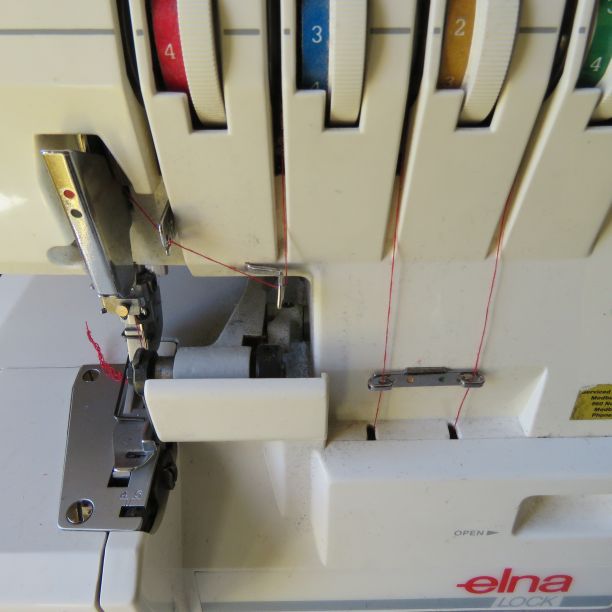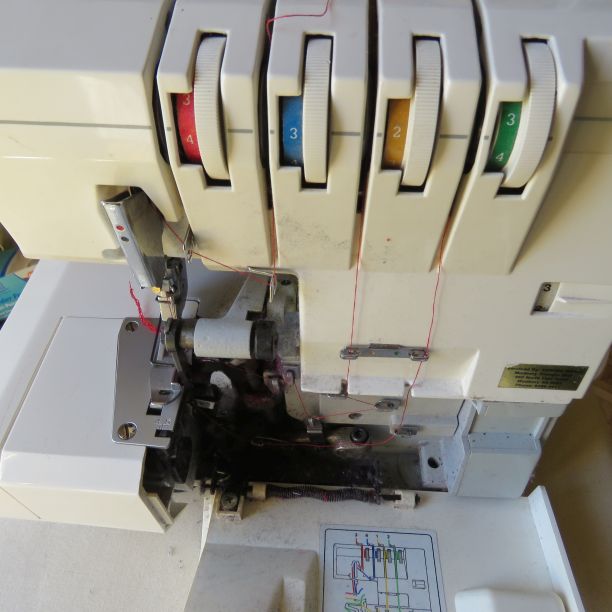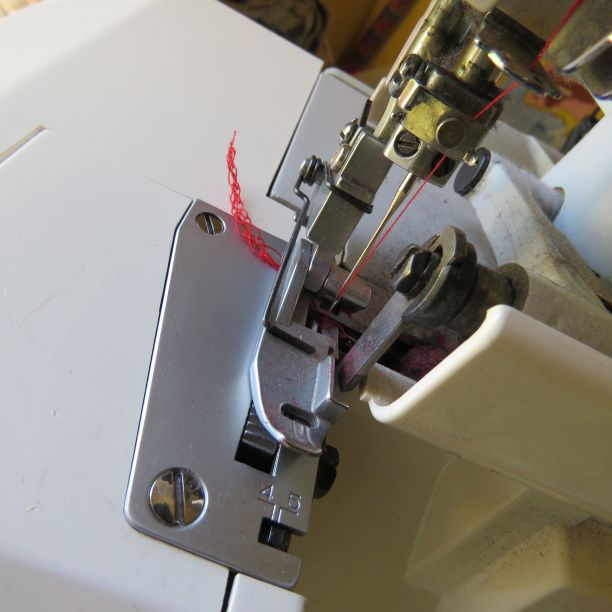Overlocker Woes: The Curse of the Lower Looper

Dear Lizzy,
How do I stop that blasted lower looper from coming unthreaded all by itself, especially starting off?
Dear Friend,
Yes, it happens to me too. Sometimes the thread on the looper jumps out of its hole and keeps on sewing – HOW?
I can offer no absolute solution, but here’s a list of things to try.
(Readers, please feel free to comment.)
First, check the obvious
Is the thread caught on any of the spools or thread holders above the machine?
While you’re there, check that the thread antennae is extended all the way up – sometimes machine vibration can make it go down a bit or twist.
Is the thread coming off the cones properly?
How about the thread you’re using?

Are you using good quality thread? OR is the thread old? OR has the thread been stored in a sunny place? Thread becomes brittle with age and this is hastened by sunlight. Sure, it looks great to have a wall of coloured thread cones in your airy light-filled attic sewing studio that has fabulous views from every window, but it’s not in the best interests of the thread!
Cheap or old thread can have weak spots that will abrade and break as the thread passes through the machine, so change the thread and see if that helps. If you’re stuck for choice with nothing else to use, I find that cheap/old thread works best as the needle thread and tends to break if you use it for the loopers.
Interestingly, some people report that black thread is the weakest and breaks more than other colours – maybe due to overdyeing?
Re-threading tips

Many machines need to be re-threaded in a certain order, and are quite picky about it. Typically, it’s the loopers first (either upper or lower depending on the brand), then the needle threads. There may be other quirks for your particular machine, such as “thread the top looper first, turn the handwheel one turn, then thread the lower looper”. Check your manual, the forums, YouTube, or all three.
When you re-thread the machine (possibly for the millionth time), pull all the threads through to sit neatly under and behind the presser foot. Have the presser foot up when you thread, so the thread will engage in the tension discs.
Cut the bottom looper thread so it’s only 5cm/2″ long – I don’t know why but sometimes it helps (for some machines it’s suggested to leave it hanging down rather than under the presser foot).
If you’re just re-threading a looper only, not the whole lot, pull your needle thread up from under the presser foot until you’re ready to sew. However, some (sensitive, highly strung) machines can sense that you’re tricking them and refuse to sew properly without a complete re-thread.
Start sewing slowly.
Some people find that it helps if they do one or more of these…
- Hold the threads behind the needle for a short way.
- Start off with a few turns of the handwheel rather than the foot pedal.
- Start off with the fabric under the foot rather than running onto the fabric.
- Rolling the threads into a rope with their fingers and pulling it to the left when they start off.
Other stuff to check

Is the needle seated properly and is the presser foot screwed in fully? Sometimes these jiggle free from the motion of the machine.
Does the needle need changing? Are you using a thicker needle for thicker fabrics etc?
If a needle has broken and jammed in the machine, it might have burred the looper, which then might abrade the thread. Run your finger along it to feel, and remedy with fine sandpaper. Once, I discovered that the bottom looper was actually bent, and grazing against the top looper, breaking the thread. I bent it back.
Finally….
Clean, vacuum, oil. Re-thread. Do it often 🙂 After taking overlocker photos for this post, I saw how filthy mine was!
Please, don’t give up on your machine. They are great, and there’s lots of help out there if you’re having hassles with it.
Cheers!
Also — it helps if you turn the wheel by hand slowly three times, with the fabric under the needle, before putting your foot on the pedal. That enables loose threads to tauten up properly, and will also tell you if anything’s wrong before you zoom away on the pedal. I also find that cursing is not helpful; cajoling and sweet talking my overlocker works a lot better than growling at it and calling it names. That is to say: PICNIC — problem in chair, not in computer (overlocker).
Thanks for adding this, Peggy, it’s a good one.
I’m with you on the gentle, sweet talk approach too! Interestingly, in every factory I’ve worked, there is always one machine (usually, but not always, a buttonhole machine) which defies everyone, except for one person who has a special touch, an innate gentle understanding, and the machine will only work for The Chosen One.